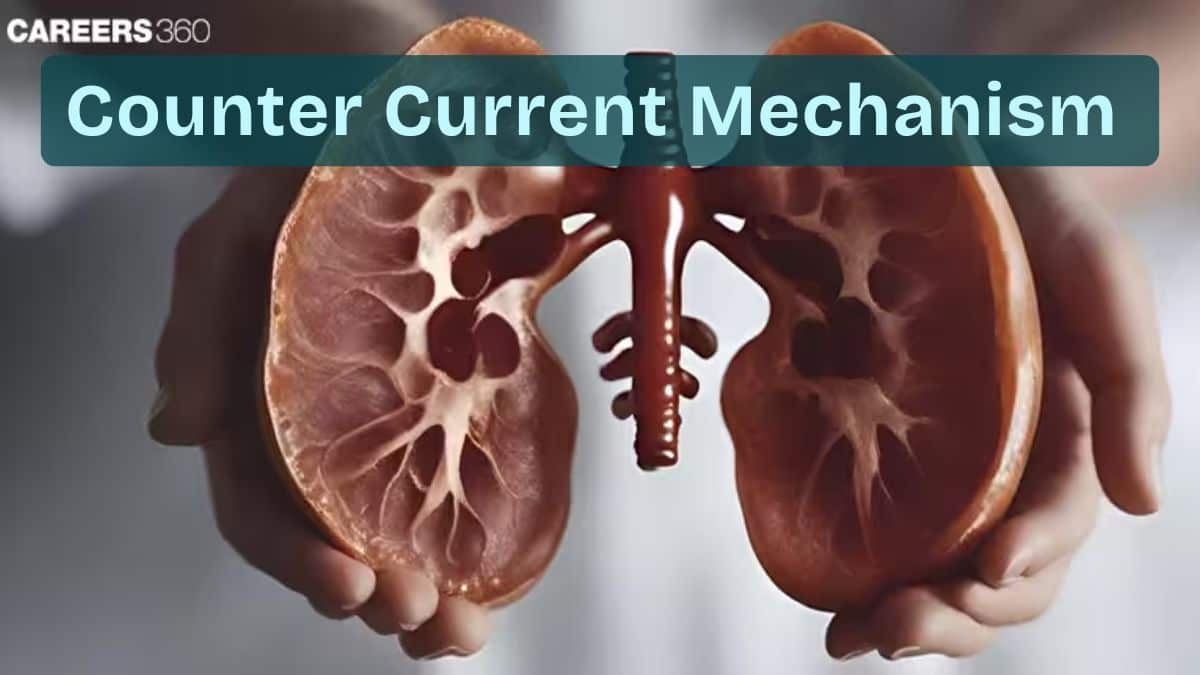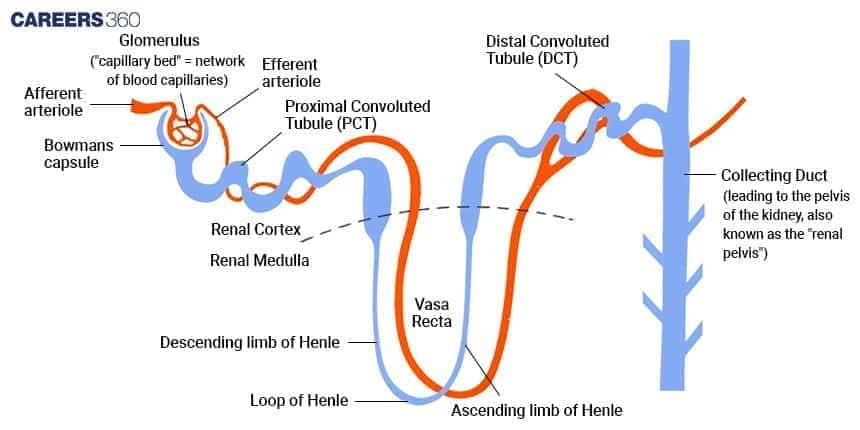Counter Current Mechanism: Introduction, Formation, Steps, And Composition
The countercurrent mechanism enables kidneys to concentrate urine by creating a steep osmotic gradient in the renal medulla. It works through the opposite flow of filtrate in the Loop of Henle and blood in the vasa recta, helping conserve water and maintain osmotic balance. This guide covers countercurrent multiplier & exchanger, flow patterns, Loop of Henle functions, vasa recta role, urea recycling, diagrams, FAQs, and NEET MCQs.
This Story also Contains
- What Is the Countercurrent Mechanism?
- Concurrent Flow Vs. Countercurrent Flow
- Countercurrent Mechanism in the Kidney
- Steps of the Countercurrent Mechanism
- Countercurrent Multiplier vs Exchanger
- Role of Urea Recycling
- Concentrated Urine Formation
- Parts of Nephron
- Countercurrent Mechanism NEET MCQs (With Answers & Explanations)
- Recommended Video on Counter Current Mechanism

What Is the Countercurrent Mechanism?
The countercurrent mechanism is an essential procedure in the kidney that enables urination to become concentrated by retaining water. It has established an osmotic gradient in the renal medulla, where the water reabsorption from the tubular fluid back into the bloodstream accompanies the excretion of excess solutes. Thus, it ensures there is a proper fluid balance in the body and generates concentrated urine.
Concurrent Flow Vs. Countercurrent Flow
The countercurrent mechanism is a process in which two fluids move or flow in opposite directions to facilitate the exchange of substances between themselves. For example, two tubes carrying solutions made of the same solute would be kept in open communication so as to facilitate some exchange of substances. Major types of flow patterns
Concurrent Flow
Both solutions in the two tubes flow in the same direction. For example, if one tube starts with 0% concentration and the other with 100% concentration, at the time they will have reached the opposite ends, both tubes will have about 50% concentration.
Countercurrent Flow
The solutions in the two tubes flow in opposite directions. In this experiment, one tube contains a solution with 0% concentration at one end, while the other contains a solution with 100% concentration at the other end. Solutions then flow in each tube to reach the middle, and it is when they meet in the middle that the substances are transferred, so at the other end, each tube's concentrations are now closer and thus maintain the efficient exchange. Since there is free exchange of substances between the tubes, by the time they reach the end, the solutions will have picked up a concentration equal to that in the other tube.
Countercurrent Mechanism in the Kidney
The countercurrent mechanism in the kidney is concerned with the cooperation between the descending limb and ascending limb of the loop of Henle. It results in the concentration gradient in the renal medulla that will make water and other solutes efficiently reabsorbed, so the kidneys will be able to concentrate the urine.
Steps of the Countercurrent Mechanism
The steps of the countercurrent mechanism:
Solute Transport (Ascending Limb)
Sodium, potassium, and chloride ions are all actively reabsorbed. This is the limb in which a hypotonic fluid leaves the tubule. This is an essential process in the establishment of the osmotic gradient in the medulla. The fluid leaving this limb is poor in solutes. Hence it contributes to the gradient for the reabsorption of water.
Water Equilibration (Descending Limb)
The thin limb of Henle is relatively permeable to water as well as small solutes. Since the tubular fluid becomes more concentrated since water reabsorption creates an area for diffusion of solutes into the fluid, it leads to equilibration of concentration between the fluid and the surrounding interstitial fluid.
Fluid Flow & Gradient Multiplication
New fluid enters the descending limb continuously, pushing more concentrated fluid down the loop of Henle. It has a countercurrent flow that creates a repetitive process in increasing the osmotic gradient. The longer the loop of Henle, the bigger the gradient, which means more effective reabsorption of water.
Countercurrent Multiplier vs Exchanger
The countercurrent mechanism works by producing a countercurrent multiplier system in which the flow of fluid in opposite directions in the descending and ascending limbs generates and maintains an osmotic gradient.
Countercurrent Multiplier (Loop of Henle)
The loop of Henle creates the osmotic gradient in the medulla by actively pumping out ions, especially through Na⁺/K⁺/Cl⁻ transporters in the ascending limb.
This energy-dependent process allows the kidney to produce concentrated urine.
Countercurrent Exchanger (Vasa Recta)
The vasa recta preserves the medullary gradient through passive exchange of water and solutes as blood flows slowly in opposite directions.
This mechanism prevents washout of the gradient while allowing efficient reabsorption.
Role of Urea Recycling
The role of urea recycling are:
Urea diffuses out of the inner medullary collecting duct into the medulla, increasing the osmolarity of the interstitial fluid.
This high osmotic gradient (up to ~1200 mOsm) facilitates greater water reabsorption from the collecting ducts.
Some of the recycled urea re-enters the loop of Henle, helping maintain the concentration gradient essential for urine concentration.
Concentrated Urine Formation
The countercurrent mechanism concentrates urine through the following steps:
NaCl is transported from the loop of Henle's ascending limb down to the vasa recta's descending limb.
NaCl is then passed on to the interstitium via the ascending limb of the vasa recta from 300 mOsm at the cortex to 1200 mOsm at the medulla.
The role of the descending limb of the loop of Henle is to transport urea into the interstitium, adding to the osmotic gradient. As the urine flows down the collecting tubule, higher concentrations of solutes in the interstitium increase water reabsorption due to osmosis and concentrate the urine.
The mechanism of countercurrent flow, along with countercurrent exchange across the vasa recta, maintains the high osmolarity in the renal medulla. Concentrated urine can then be produced with water conserved.
Parts of Nephron
The parts of a nephron are:
Glomerulus: Filtrates blood to form filtrate.
Bowman's Capsule: Collects the filtrate from the glomerulus
Proximal Convoluted Tubule: Reabsorbs nutrients, ions, and water.
Loop of Henle: Concentrates urine by the reabsorption of water and salts.
Distal Convoluted Tubule: Fine adjustment in the composition of fluid.
Collecting Duct: Finally concentrates the urine.

Countercurrent Mechanism NEET MCQs (With Answers & Explanations)
Important questions asked in NEET from this topic are:
Steps of Urine Formation
Role of Kidneys in Osmoregulation
Practice Questions for NEET
Q1. The counter-current mechanism involves ____?
Vasa recta and PCT
Vasa recta and DCT
Vasa recta and loop of Henle
Vasa recta and collecting duct
Correct answer: 3) Vasa recta and loop of Henle
Explanation:
The flow of filtrate in the two limbs of Henle’s loop is in opposite directions and thus forms a counter current. The flow of blood through the two limbs of the vasa recta is also in a counter-current pattern.
This mechanism helps to maintain a concentration gradient in the medullary interstitium, thereby concentrating the filtrate( urine).
Hence, the correct answer is option 3) Vasa recta and loop of Henle.
Q2. Among the options provided, which blood vessel in mammals contains the minimal quantity of urea?
Hepatic portal vein
Hepatic vein
Dorsal aorta
Renal vein
Correct answer: 4) Renal vein
Explanation:
The renal vein, which carries blood away from the kidneys, contains the least amount of urea among the given options. This is because the kidneys are responsible for filtering waste products, including urea from the blood. As the filtration and reabsorption processes occur in the kidneys, water and essential nutrients are reabsorbed while waste products like urea remain in the tubular fluid. Consequently, the remaining fluid, known as urine, flows out of the kidneys and into the renal vein. Compared to other blood vessels involved in filtration, such as the hepatic portal vein and hepatic vein, the renal vein has a lower concentration of urea. Thus, the renal vein contains a minimal quantity of urea.
Hence, the correct answer is option 4) Renal vein.
Q3. Mammals have the ability to produce
Isotonic urine
Hypertonic urine
Hypotonic urine
Highly alkaline urine
Correct answer: 2) Hypertonic urine
Explanation:
Mechanism of Concentration of Urine -
Mammals can produce concentrated urine.
The Henle’s loop and vasa recta play a significant role in this.
The flow of filtrate in the two limbs of Henle’s loop is in opposite directions and thus forms a counter current.
The flow of blood through the two limbs of the vasa recta is also in a countercurrent pattern.
The proximity between the Henle’s loop and vasa recta, as well as the countercurrent in them, help in maintaining an increasing osmolarity towards the inner medullary interstitium, i.e., from 300 mOsmolL–1 in the cortex to about 1200 mOsmolL–1 in the inner medulla.
This gradient is mainly caused by NaCl and urea.
NaCl is transported by the ascending limb of Henle’s loop which is exchanged with the descending limb of vasa recta.
NaCl is returned to the interstitium by the ascending portion of the vasa recta.
Similarly, small amounts of urea enter the thin segment of the ascending limb of Henle’s loop which is transported back to the interstitium by the collecting tubule.
The above-described transport of substances facilitated by the special arrangement of Henle’s loop and vasa recta is called the countercurrent mechanism.
This mechanism helps to maintain a concentration gradient in the medullary interstitium.
The presence of such an interstitial gradient helps in the easy passage of water from the collecting tubule thereby concentrating the filtrate (urine).
The overall function of the countercurrent mechanism is to concentrate the sodium chloride in the interstitial fluid and thereby cause water to diffuse out of the collecting ducts and concentrate the urine.
Human kidneys can produce urine nearly four times more concentrated than the initial filtrate formed.
Mammals produce hypertonic urine.
Hence, the correct answer is option 2) hypertonic urine.
Also Read:
Recommended Video on Counter Current Mechanism
Frequently Asked Questions (FAQs)
Tubular reabsorption changes useful substances back into the blood. On the other hand, tubular secretion adds waste substances to the tubular fluid for excretion.
Water, glucose, amino acids, sodium, potassium, chloride, and bicarbonate are typically reabsorbed.
Aldosterone and other hormones control the transfer of ions. This will shift the makeup and pH of urine.
It could be linked to abnormalities of reabsorption or secretion with disorders such as diabetes mellitus, renal tubular acidosis, or abnormalities in electrolytes.